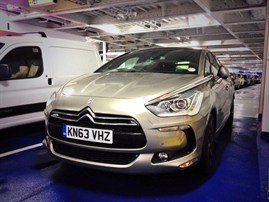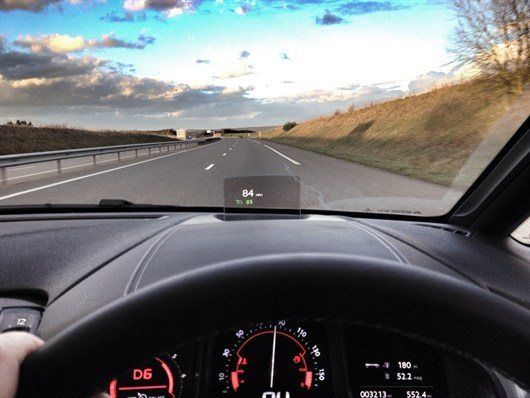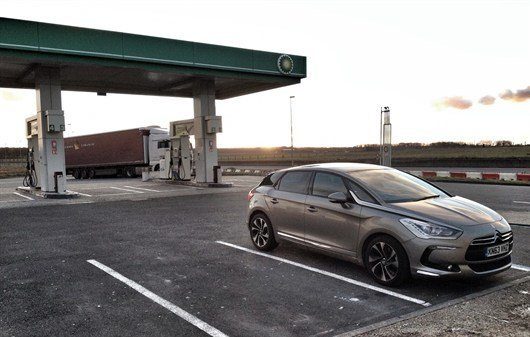Autoroute or route nationale? Let the DS5 decide...

Readers of Honest John Classics will be well aware that last week was dominated by the Retromobile show. The classic car event is held in the centre of Paris, at the Parc des Expositions, and given it's a 170-mile drive from Calais, it seemed the perfect opportunity to spend a weekend driving, with a car I've been wanting to get to know a little better - the Citroen DS5.
I've been a fan of big Citroens for as long as I can remember. It's a passion that dates back to a Matchbox Citroen SM bought for me, as a toddler, and which remained strong to the point I was old enough to start buying cars. I've had more than a dozen BXs, tons of Xantias and XMs, each distinguished by their Hydropneumatic suspension, and unconventional styling. Over the years, I've also found that as appealing as they are to me here in the UK, it's only when you cross the Channel and spend some time in one in France, that they truly come into their own. And with that in mind, what better test is there for these cars' spiritual successor?
 Heading out on the P&O cross Channel ferry (right) is always a good start - as long as you're not in too much of a rush. It sets the stall for the beginning of any trip, making an event of the crossing, instead of a quick trip through the pipe, where you don't even see the sea. Once out on the other side, you're straight on to France's motorway network - and for this trip, that's the way I'd be heading for Paris.
Heading out on the P&O cross Channel ferry (right) is always a good start - as long as you're not in too much of a rush. It sets the stall for the beginning of any trip, making an event of the crossing, instead of a quick trip through the pipe, where you don't even see the sea. Once out on the other side, you're straight on to France's motorway network - and for this trip, that's the way I'd be heading for Paris.
So far, I've not really warmed to the DS5. Initial thoughts centre on its unconventional control layout, bony ride, and slightly unexceptional fuel consumption (40mpg from the 163PS 2.0-litre turbodiesel), if the trip computer was to be believed. But as my drive from my home in the East Midlands to Calais has been in the small hours of the morning, in dark, stormy conditions, surrounded by battling white vans, that's not exactly unexpected.
In terms of handling the teeming rain and wind, I can't fault the DS5's stability - in that respect, it feels like a big Citroen should. Arrow straight and dependable.
Now for the three-hour motorway shlep down to Paris. The winds are howling, but at least it's dry as we head down the coast to Boulogne and onwards. The good news is that on France's spookily empty autoroutes, the DS5 settles down to a very comfortable cruise. But the surface is smooth and consistent, the cruise control is child's play to use, and the head-up display is really useful. The rest of the controls are a mixed bag - I can't see a way of entering post codes into the sat-nav, and if there's a way of hooking up my Bluetooth 'phone (there is, as the option to stream music is there), buggered if I can see it.
But the DS5 is very much at home in this environment - a modern French executive car on modern French tarmac is a winning combination.
In Paris, the DS5's smooth autobox and electronic handbrake (it comes on and releases progressively) are good points, but its shocking visibility comes to the fore. Although it's not bad head-on, and the A-pillar is not too obstructive, the high flanks, and narrow windows make this a car for threading around city streets very tentatively indeed. But I get to the show in one piece, and far less stressed than I might have done.

Camera mount captures the DS5 doing what it does best at a GPS-accurate 130km/h.
The following day is return day, and I decide to eschew the autoroute. As a method of getting from one end of the country to another in the minimum amount of time it's brilliant - but faceless service stations, miles upon miles of grey tarmac, unmanned toll booths and refrigerated baguettes are no way to experience this wonderful country first hand. So I decide to leave a couple of hours early, dial in 'no tolls' on the sat nav, and head north the rustic way.
Once out of Paris' sprawling suburbs, and clear of its multiple car accidents, we settle into a more relaxed way of thinking. Ambling up the routes nationales, at 56mph, trundling through villages, and enjoying the rolling scenery of the Somme. It's a world away from the DS5's natural habitat, though, and at times, the thumping suspension reminds me far too rudely of the fact. But despite the discomfort, this really is the best way to travel through France - it's a beautiful place, the roads are good, and the pace of life is - largely - relaxed.
But should I really bemoan the loss of the loping ride quality that distinguishes classic big Citroens such as the CX and DS - and even the more recent C6? And would this DS5's natural stamping ground be where I'm driving it today, as opposed to where it chauffeured me yesterday? After all, buyers vote with their feet, and it would seem that they really don't want softly-sprung big cars any longer. Aside from the C6, the only other large European cars of note I can recall favouring ride comfort over a set-up designed at the Nurburgring were the Skoda Superb Mk1 and Rover 75.
But that doesn't mean Citroen needs to follow the herd, surely? The DS5's styling is as advanced as the CX or XM's was in its day, and the interior easily as beautiful as an SM's. It's an interesting addition to the upper-medium market - and although it lacks the crushing all round consistency of its German rivals, it's an endearing, striking, and likeable car with so much to offer. So why is it saddled with ride quality that's the same as everyone else's?
Back in the 1990s, Citroen had the answer, with the Xantia Activa - a car that combined pillow-soft ride, with zero-roll cornering - and yet, for reasons of cost and complexity, the company walked away from the system. Only now is the world catching up. Perhaps it's time Citroen considered doing a U-turn on its decision to kill its fluid suspension when the C5 goes out of production, and give us a suspension set-up that the striking DS5 really deserves...


 Keith Adams
Keith Adams
 Honest John Awards 2017: Land Rover Discovery Sport named Most Popular SUV for second year in a row
Honest John Awards 2017: Land Rover Discovery Sport named Most Popular SUV for second year in a row
 2022 Smart #1 SUV: price, specs and release date
2022 Smart #1 SUV: price, specs and release date
 2023 Ferrari Purosangue SUV: Prices, specs and release date
2023 Ferrari Purosangue SUV: Prices, specs and release date
 Citroen DS3 Racing revealed
Citroen DS3 Racing revealed
 Infiniti adds diesel to the range
Infiniti adds diesel to the range
 Volvo XC90 chosen as SUV of the year at 2014 Honest John Awards
Volvo XC90 chosen as SUV of the year at 2014 Honest John Awards
 March new car registrations better than expected
March new car registrations better than expected

.jpg)






Add a comment